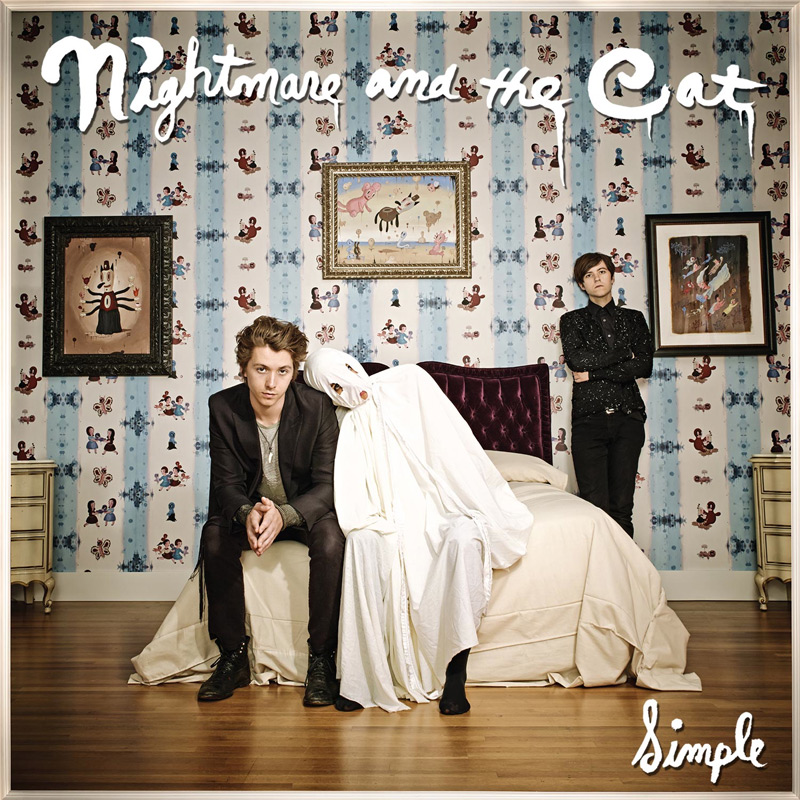Gary Baseman: The Door is Always Open
The artist’s family heritage and childhood home inspire an interactive retrospective complete with custom wallpaper

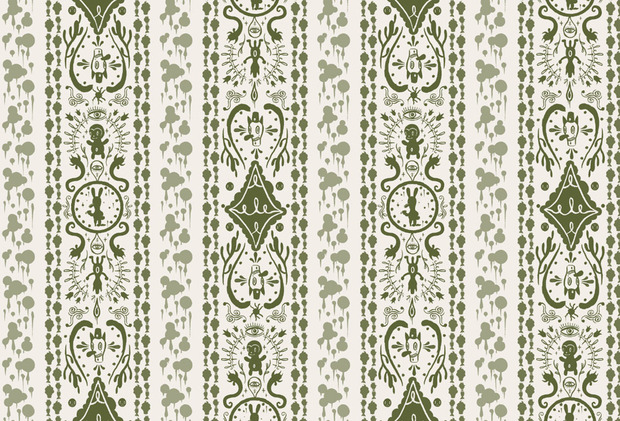
Gary Baseman fills his world with a recurring cavalcade of characters. His constant companion Toby, the adorable ChouChou and creatures large and small fill forests, gardens and shrines and seemingly float through air. But the whimsy and fantasy can have a dark edge, depicting dramatic escapes and scores of bloody, fanged monsters exploring everything from dreams and nightmares to sexuality and religion. Now Baseman’s prolific body of work, with all of its color and imagination, will be on view at LA’s Skirball Cultural Center in his new exhibition “The Door Is Always Open“—a phrase often repeated to him by his father.
This time the show takes an intensely personal turn with elements representing every phase of Baseman’s career, including paintings, illustration, toy design, his animated television show Teacher’s Pet and performance art. Baseman was not content to set up rooms of his work; rather, he has taken on the massive challenge of recreating a stylized version of his childhood home and filled it not only with his life’s work but also family furniture and mementos—he even traveled to Eastern Europe to visit the World War II sites where his grandparents perished in the Holocaust and his father fought as a partisan. Baseman has taken the idea of a retrospective and turned it into a biographical excavation of his family heritage and his colorful life in the art world.
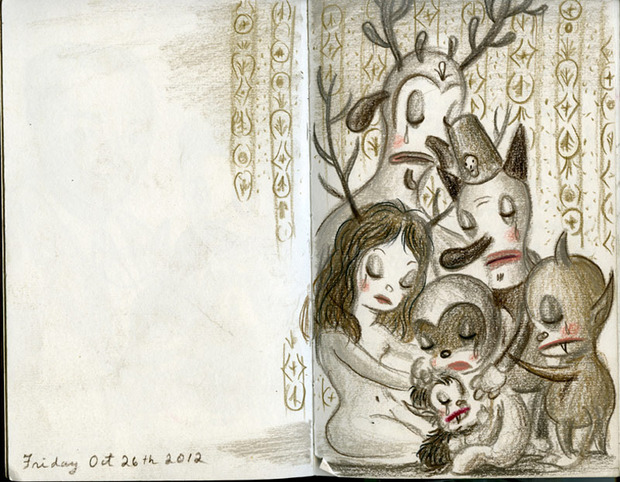
Almost every night Baseman has been posting a close-up of his characters and work to wish his almost 8,000 Instagram followers “sweet dreams.” He wakes up in the morning to continue overseeing every detail of the exhibition from the development of wallpaper patterns to the layout of objects and artworks. We visited Baseman at his studio while he was finishing “Mythical Creatures,” a large painting of a forest for the show filled with his beloved flying girls, his Bloody Buckingham Warrior, miniature fairies, gefilte fish and hearts. In the spirit of creating the true feeling of a house, Baseman collaborated with Astek Wallcovering Inc. to create wallpaper designs that will hang as a representation of his childhood home. We talked to Baseman about developing the concept for his show and how the wallpaper helps transform the exhibition halls at the Skirball Cultural Center into his home.

Wallpaper composed of your art and characters fills the rooms of your show. How did you originally connect with Astek to make the wall coverings?
I was trying to figure out what to do because I was building a house for the exhibition. We were thinking about doing furniture, so I wanted to get fabric produced. Then from fabric it turned into wanting to do wallpaper for the rooms too, which I thought was amazing. My dear friend Barb Perlin, who I have know since we went to college at UCLA, found Astek. She set up a meeting and I met with the owner, Aaron Kirsch. They do work with Mad Men and American Horror Story. They are so good—I just loved everything they did. They have machines the size of this house.
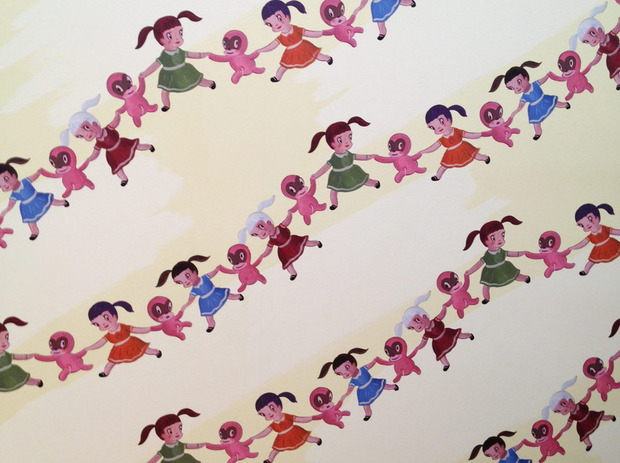
Was the first design that was produced the one that appeared in “The Nightmares of Halloweens Past”?
I worked with them and we did a test. So we had an exhibition of my vintage Halloween mask photos. With the first wallpaper, they went all out. Not only did they do a wallpaper of my flower pattern, but they made it with mylar. It’s this shiny silver coming out of the black. It was so beautiful. From there I have been working with their designer Gabe Gonzales. I gave him a catalog of images and we put together wallpaper, some of it very playful and others that felt appropriate for specific rooms.
How did you develop the design for each room in the exhibition?
In the living room there is no wallpaper—it’s kind of the introduction. Then when we came to the dining room we wanted to create wallpaper that had a kind of formal feel, but still worked within the scope of my art. I grew up with this interesting wallpaper pattern in my parents’ hallway that has haunted me. I used that as an inspiration in my “Walking through Walls” exhibition, but I did not use it directly, just the idea of the wallpaper and this pattern. Every time I walk through that hallway, it’s so mysterious, dealing with a sense of dreams in a way. So we took that and we used that for the dining room. We took the basic pattern of my parents’ wallpaper and incorporated my characters and symbols.
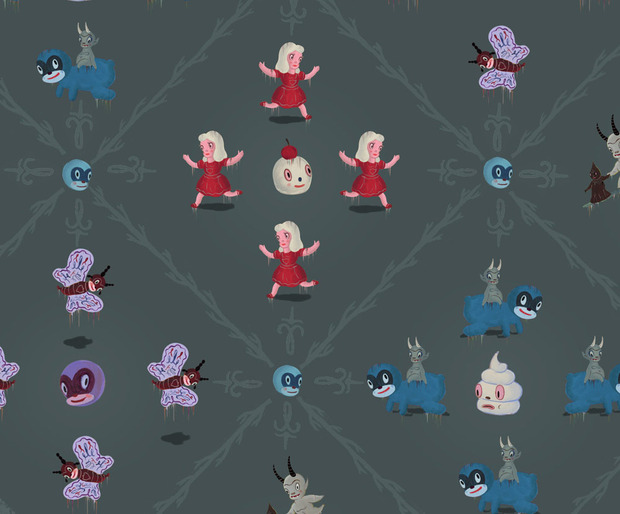
What other wallpapers are in the exhibition?
“I was trying to use the house as a vehicle to tell my story so each room in the house represents a theme in my art.”
The Halloween show wallpaper is on the walls in the study. It’s much more about inspiration and heritage. It tells my parents’ story. I wanted something that had a more solemn kind of feel. In the office, there is a dark gray playful pattern. The office in the exhibition is about work and my career as an illustrator. You go into the den and that’s where we have the Giggle and Pop wallpaper. That is based on the art performance piece that I did at LACMA a few years ago, where I had my ChouChous and Wild Girls dancing, singing and getting people to lose their inhibition. We are using that in the den. We are using two wallpapers in the bedroom. Two walls will be dreams and two walls will be nightmares, but even the nightmares aren’t really nightmares—more of my character Vicious from an exhibition I had in Milan. Then the dreams are much more ChouChou focused.
What is happening in the garden area of the show?
The backyard is for performance. They have my costumes. They have other paintings. They have my Enlightened Chou shrine. They are also going to show a Super 8 film I made when I was 14.
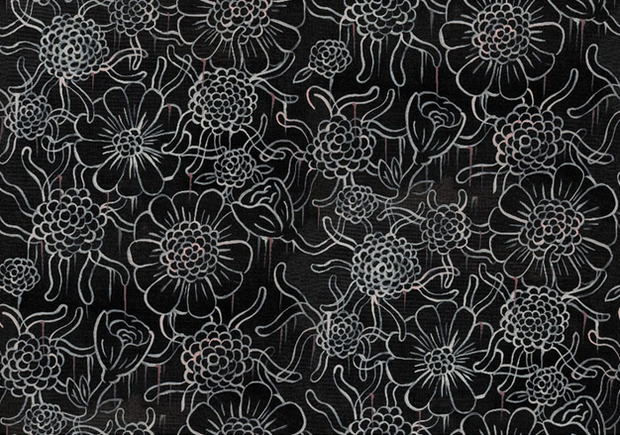
Why did the wallpaper project end up being such an integral part of building the house for the exhibition?
I didn’t think it would be. I was trying to use the house as a vehicle to tell my story so each room in the house represents a theme in my art. The dining room represents celebration. The hallway is about journey. The den is about play. The backyard is about art performance. I wanted to incorporate it because I wanted the feel of my world that existed in this home. The show includes the kitschy ’60s furniture that I grew up with. The furniture in it is actually my family’s furniture. It is my parent’s furniture in the dining room, their dining room set that they lived with for 48 years.
A few weeks ago was the first time it was ever removed from the home. So is the bedroom set. When you go to the coffee table, it’s the coffee table I used to sit under as a little kid and draw. When you go into the den, the TV that is going to be playing Teacher’s Pet is actually the TV that I grew up with as a little kid. My older brother Sam would sit in front of it because this was before there were remote controls and he would turn the channels. So a lot of it is very personal. With the wallpaper it adds this magical quality. I want the people to be engaged in the exhibition. I want people to sit in the sofas. I want them to be able to feel at home and to know it’s not just “The Door Is Always Open,” but also the creative door is always open. I want to inspire them to sit down with their sketchbooks. We will have sketchbooks available for people to do a drawing or to leave a note or to write a story to tell something about themselves.
“The Door Is Always Open” opens 25 April and runs through 18 August 2013 at the Skirball Cultural Center in Los Angeles. Astek will be producing Baseman’s wallpaper for purchase.

